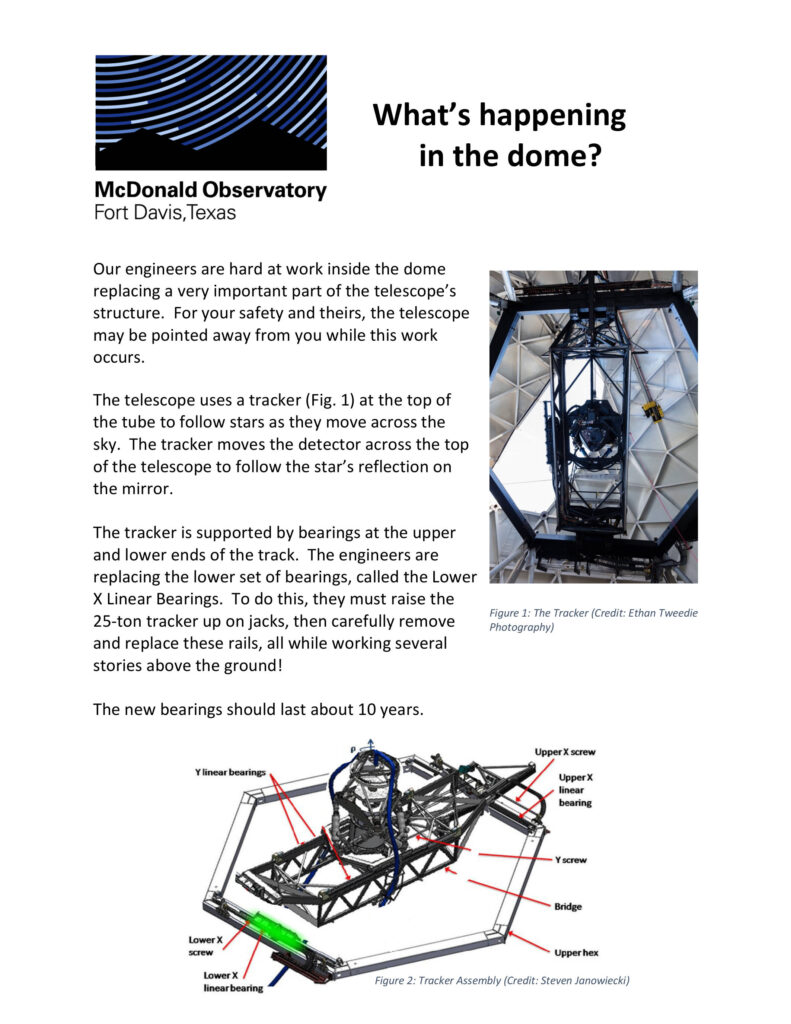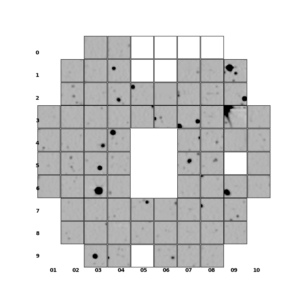If you want an inside look at night operations from the HET control room, check out the recording of a recent live stream event we produced in cooperation with the McDonald Observatory Visitor Center:
Author Archives: Steven Janowiecki
Tracker maintenance this week
Starting today (14 March, 2022 – Pi day!) the HET is offline for some tracker maintenance. The work is described in the informational sheet below, provided by the Visitor Center:
Snowy HET
On Thursday January 20th, 2022 we had a beautiful snowfall of 4-6″ at the observatory. Unfortunately the roads became difficult to drive on and the snow on top of the HET’s dome meant we couldn’t open at night (the snow would fall onto the primary mirror). Still, it was a beautiful snow day! Photo below from Stephen Hummel:
HPF detector maintenance
This past week the HPF instrument team has been working on the detector hardware. Over the past few years the bias/pedestal level has been slowly rising and recent exceeded 40k counts (of a total 65k available to the A/D converter). This high pedestal had begun impacting our ability to observe bright targets without saturation. The graph below shows the gradual rise of this pedestal level since 2019, and the rapid drop achieved this week during the detector maintenance. While the underlying cause of the pedestal rise is unknown, we anticipate that HPF will return to normal science observations in the coming days.
VIRUS at 78
HPF searches for evaporating helium around young planets
Technical paper from HPF
For those interested in an amazing tour de force of extreme precision radial velocity measurements, check out this new paper from Shubham Kanodia (PSU) and the HPF team. It is described in this excellent post which also includes great diagrams and video content. Take a look and learn how HPF+HET is making some of the most precision measurements possible of Earth-like planets in the habitable zones of M dwarf stars!
https://hpf.psu.edu/2021/06/24/hpf-scrambling/
HPF science updates
The Habitable zone Planet Finder continues advancing the field of exoplanets! See below for a round-up of recent updates:
Astronomers Disprove Planet Orbiting Nearby Barnard’s Star
https://mcdonaldobservatory.org/news/releases/20210518
A very stealthy alias: the impostor planet of Barnard’s star
https://hpf.psu.edu/2021/05/06/wavelength-dependent-behavior-of-the-hpf-fabry-perot/
HETDEX survey on track towards completion
This week there have been a few press releases from the HET partners about our progress on the HETDEX survey so far. The graphical presentation of the data is amazing and the whole survey will represent a major accomplishment for observational cosmology once completed. Read more at the following links below.
Meanwhile, our hearts are with the radio astronomy community as they mourn the not-unanticipated structural failure of the Arecibo radio telescope this week. Send warm thoughts to all the large aperture telescopes being maintained out there – they are are precious tools to view the cosmos and is is quite sad to lose such a giant.
https://mcdonaldobservatory.org/news/releases/20201201
https://news.psu.edu/story/640405/2020/12/01/research/hobby-eberly-telescope-dark-energy-experiment-survey-begins-full
https://phys.org/news/2020-12-hetdex-track-probe-dark-energy.html
Giant planet orbiting a white dwarf
Another day, another amazing planet! This week also saw an exciting announcement about a giant exoplanet orbiting very close to a white dwarf — possibly the first such planet discovered to survive its star’s death throes. This work was led by Andrew Vanderburg and also includes Caroline Morley and Andreia Carillo. This work used used TESS and Spitzer data, and included a high quality HET spectrum to confirm the nature of the white dwarf. This research was published Sept. 16 in Nature. You can read the press release here:
https://mcdonaldobservatory.org/news/releases/20200916a
and the full article at Nature:
https://www.nature.com/articles/s41586-020-2713-y
or the freely available version on the pre-print arXiv:





